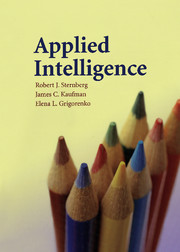Book contents
- Frontmatter
- Contents
- Preface
- 1 Views of Intelligence
- 2 The Theory of Successful Human Intelligence
- 3 Metacognition: Thinking with Metacomponents
- 4 Advanced Problem-Solving Steps
- 5 Cognitive Processing: Performance Components (I)
- 6 Cognitive Processing: Performance Components (II)
- 7 Logical Reasoning and Analysis of Arguments: Performance Components (III)
- 8 Inference and Inferential Fallacies
- 9 Knowledge-Acquisition Components
- 10 Coping with Novelty
- 11 Deciding for Creativity
- 12 Automatizing Information Processing
- 13 Practical Intelligence
- 14 Why Intelligent People Fail (Too Often)
- References
- Author Index
- Subject Index
12 - Automatizing Information Processing
Published online by Cambridge University Press: 09 November 2009
- Frontmatter
- Contents
- Preface
- 1 Views of Intelligence
- 2 The Theory of Successful Human Intelligence
- 3 Metacognition: Thinking with Metacomponents
- 4 Advanced Problem-Solving Steps
- 5 Cognitive Processing: Performance Components (I)
- 6 Cognitive Processing: Performance Components (II)
- 7 Logical Reasoning and Analysis of Arguments: Performance Components (III)
- 8 Inference and Inferential Fallacies
- 9 Knowledge-Acquisition Components
- 10 Coping with Novelty
- 11 Deciding for Creativity
- 12 Automatizing Information Processing
- 13 Practical Intelligence
- 14 Why Intelligent People Fail (Too Often)
- References
- Author Index
- Subject Index
Summary
WHAT IS AUTOMATIZATION?
Think about what happens when you read a newspaper or a magazine article. Unless the article is unusually technical or poorly written, the chances are that you can understand it fairly easily. You are probably barely aware of the mental processing you are doing while you are reading, despite the enormous complexity of the reading process. Because you are, most likely, a skilled reader (at least, in comparison to young children), you can concentrate on absorbing the new facts and ideas in the article. You don't have to pay attention to things such as what the individual letters of each word are, how the words are pronounced, how the words fit together to form sentences, what the words mean, and so on. If you were in early elementary school, however, you would not be able to devote as much attention to absorbing the main facts and ideas of the article. Rather, you would have to concentrate on some of the basic processes – such as letter and word encoding, figuring out meanings of words, and so on – that are required for basic reading comprehension.
Stated in another way, as an adult reader, you have automatized – or made automatic – the lower level information processing involved in reading. As a result, you are able to devote most of your mental resources to understanding the higher-level information contained in a text. Young children have not fully automatized the processes of reading.
- Type
- Chapter
- Information
- Applied Intelligence , pp. 305 - 353Publisher: Cambridge University PressPrint publication year: 2008



